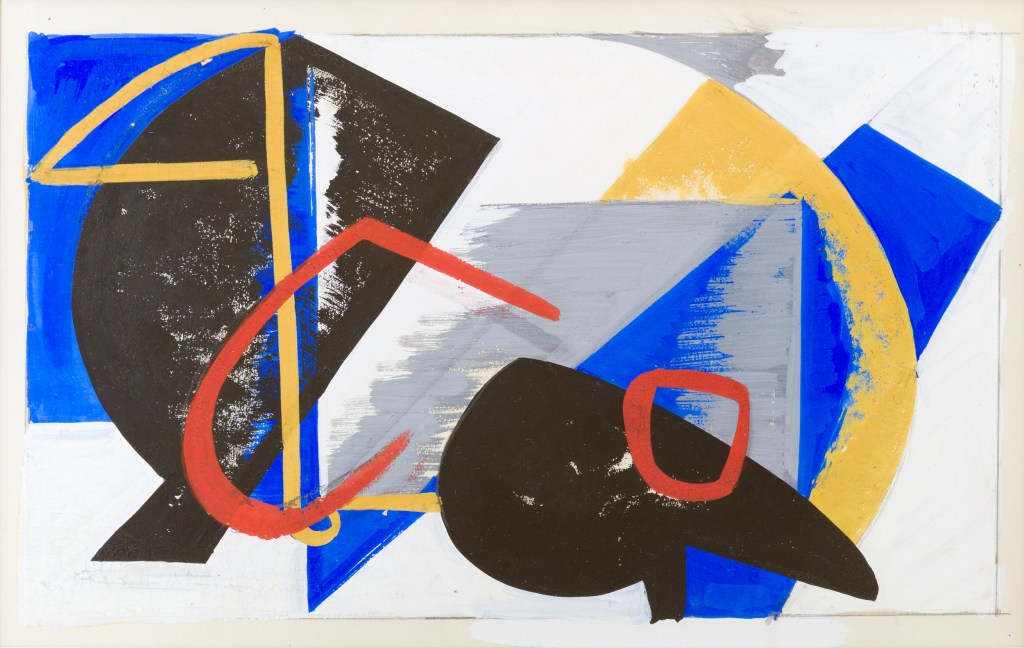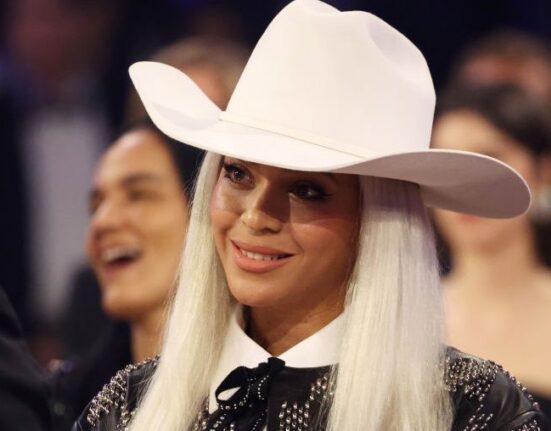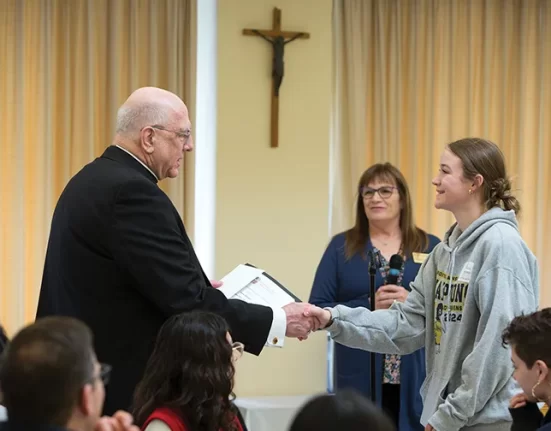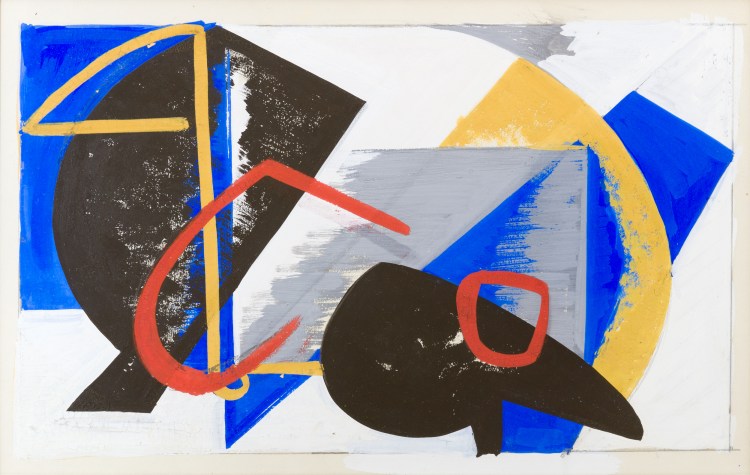

Lee Krasner, “Untitled,” 1942, gouache on mat board, 6 1/8 x 10 inches. The Pollock-Krasner Foundation, courtesy of Kasmin Gallery, New York. © The Pollock-Krasner Foundation / Artists Rights Society (ARS), New York. Christopher Stach
A visit to the Ogunquit Museum of American Art is a summer must. With its dramatic views of Perkins Cove, no other museum in Maine is so exquisitely sited. And the wildness of the scene also happens to contrast interestingly with “Lee Krasner: Geometries of Expression” (through Nov. 17), which presents an oft-overlooked period of her work and that of her peers, all of whom were inspired by the ordered, rational precepts of geometric abstraction. Concurrent with Krasner is “Domestic Modernism: Russell Cheney and Mid-Century American Painting” (also through Nov. 17), which is a wonderfully surprising sleeper of a show.
First, a clarification. Of the 40 or so works on display, only about a third are actually Krasner’s. The rest are by contemporaries, both well known (Ilya Bolotowsky, Burgoyne Diller, Alice Trumbull Mason) and more obscure (Vaclav Vytlacil, and Balcomb and Gertrude Greene). This might strike some as a bit disingenuous, except that here the illumination and articulation it offers about the era and its variety of movements and artistic influences turns out to be one of the show’s greatest assets, offering a vivid picture of a particularly febrile period in American art (and political) history.
It also presents Krasner in her own right, incontestably honoring her as the force of nature she was, quite distinct from her husband, Jackson Pollock, who is barely mentioned in materials and wall texts. This is as it should be. The latest Krasner works in the show date to 1942, around the time she met Pollock, by which point she had already accomplished a helluva lot. It was Krasner, in fact, who introduced Pollock to the critic that promoted his works and, arguably, made him famous: Clement Greenberg. And it was Krasner who nurtured Pollock at her own great personal and professional expense.
One thing that emerges loud and clear through this exhibit is Krasner’s strong-willed, activist identity. Though the exhibit doesn’t go deeply into her origins and political leanings, her working-class Jewish background and Russian émigré status had a lot to do with her tenacious defense of the labor movement and unionization, for which she picketed (leading to unfounded accusations that she was a Communist). She also protested the Museum of Modern Art’s refusal to show American abstract artists. Krasner felt she was part of a revolution in painting, and all evidence seems to point in this direction.
The context in which her activism arises in the exhibition is in the discussion among Krasner and her peers about what should be christened the appropriate American art for the tumultuous times in which they were living. As an introductory wall text explains:
“(Krasner) cemented her place as a dynamic voice among artists exploring abstraction in New York City. This period was rocked by the social and economic upheaval of the Great Depression (1929-39), which heightened nationalist debates about American culture and identity. Abstraction, and particularly geometric abstraction, was a visual language that Krasner and her peers believed would bring American art into an ongoing global conversation on how to represent the experience of modernity. They argued that abstraction, unimpeded by storytelling or the task of representing the world, could best express the intensities and simultaneity of life at the time.”
Consistent throughout is the uniqueness of Krasner’s forays into genres swirling about her in the 1930s and ’40s. These include ideas drilled into her by her teacher Hans Hofmann and his theory of “push pull” (creating tension between colors and forms to activate the surface of a canvas), Russian Constructivism and Suprematicism.
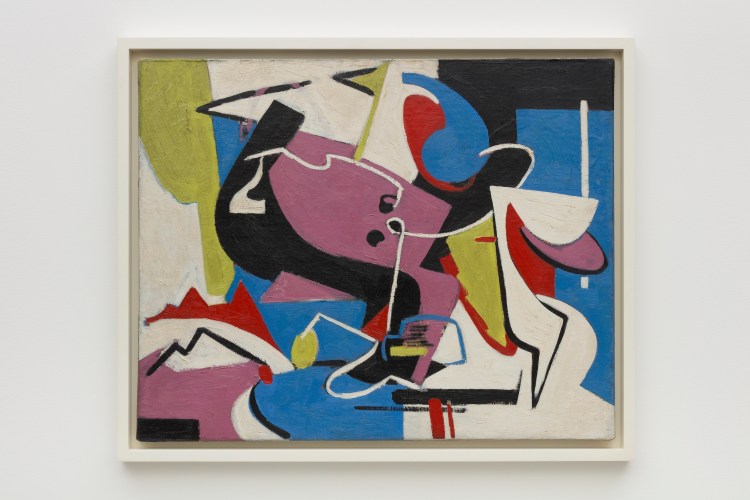

Lee Krasner, “Lavender,” 1942, oil on canvas, 24 x 30 inches. Guillermo Gonzales. Courtesy of the Olivia Collection, Los Angeles and Mexico City. © The Pollock-Krasner Foundation / Artists Rights Society (ARS), New York
We see, for instance, Krasner’s “Lavender” hanging not far from Bolotowsky’s “Geometry on Green.” Both paintings have kindred intentions: pure abstraction, the arrangement of shapes in space, the desire to communicate feeling. Yet the similarities end there. While Bolotowsky’s shapes hover above his green ground, they are ordered, and each shape is self-contained, rather than overlapping or intruding on the spaces of other forms. There is a warmth to the color, but there is also a kind of static quality to the work.
Hovering is not the same as moving – indeed, churning – which is what Krasner’s painting does. The compositional complexity of “Lavender” is far more layered than Bolotowsky’s, its colors brighter and more charged, its sense of movement and dancing almost delirious. This is not a critique of Bolotowsky, but an observation about how much more was going on in Krasner’s head and heart than many of her peers. She was obviously full to bursting.
Along this same wall are beautiful works by other artists, particularly “Composition in Construction,” a more cubist painting by Charles Green Shaw, and “37X1,” a paper collage construction by Gertrude Greene (“credited as being the first American artist to create abstract constructions made of cut and painted panels of wood and Masonite,” the label informs us). These are sublime in their own way, but nothing approaches the energy and emotional or visual impact of “Lavender,” which nearly explodes off the wall, apart from the works that surround it.
Only in Krasner’s “Untitled,” ca. 1939-1940, a Piet Mondrian-like painting, does her idolization of one of her most revered artists get in the way. There is no doubt she was in the thrall of the Dutch artist who brought Neo-Plasticism into the era’s lively conversation of pure abstraction. Though it is quite finely and rigorously executed, it’s harder to find Krasner in this painting. There’s something too slavishly admiring about it.
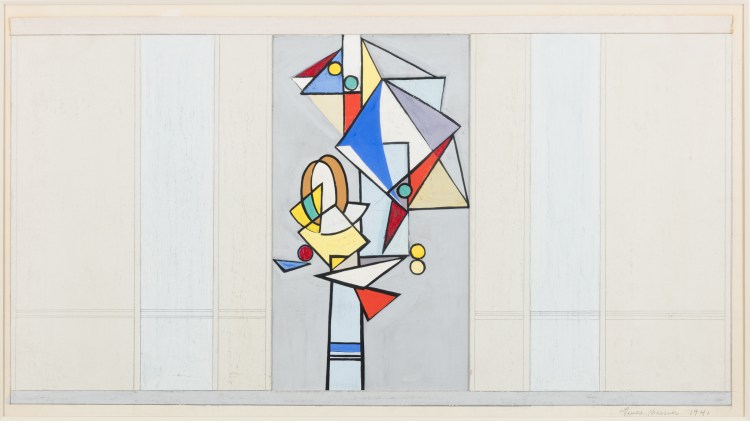

Lee Krasner, “Untitled (Alternative Study for Mural, Studio A, WNYC),” 1941, gouache on paper, 14 x 11 inches. The Pollock-Krasner Foundation, courtesy of Kasmin Gallery, New York. © The Pollock-Krasner Foundation / Artists Rights Society (ARS), New York. Christopher Stach
On the other hand, the small gallery where this work hangs holds three of my favorite pieces in the show. In the far-left corner of the room when you enter is a trio of exquisite gouache-on-mat-board mural studies from the period during which she worked with the Works Progress Administration, or WPA, FDR’s economic relief and work program for artists. They reveal the ways she synthesized ideas absorbed from Hofmann, Joan Miró, Mondrian – and, I would dare say, Wassily Kandinsky and Arshile Gorky – to forge a completely idiosyncratic personal style.
It’s a gorgeous, intriguing and beautifully curated show not to be missed.
UNCONVENTIONAL DOMESTICITY
Just a footnote here to mention the small show of Russell Cheney’s paintings in an adjacent gallery. Since arriving at the Ogunquit Museum, curator Devon Zimmerman has done something so smart that it’s a wonder no one thought of it before: that is, creating new scholarship and exhibition opportunities for works by gay artists, many – such as Carl Spinchorn and Channing Weir Hare – in the museum’s own collections. The town has long been a haven for members of the LGBTQ+ community, yet the museum rarely represented work by gay artists.
Times, thank goodness, have changed. Cheney, who lived in apparently blissful domesticity with his literary historian partner, F.O. Matthiessen, between Boston and Kittery Point, was a fine painter. Though he was not revolutionary like Krasner, he did some very beautiful work, particularly when it came to portraiture.
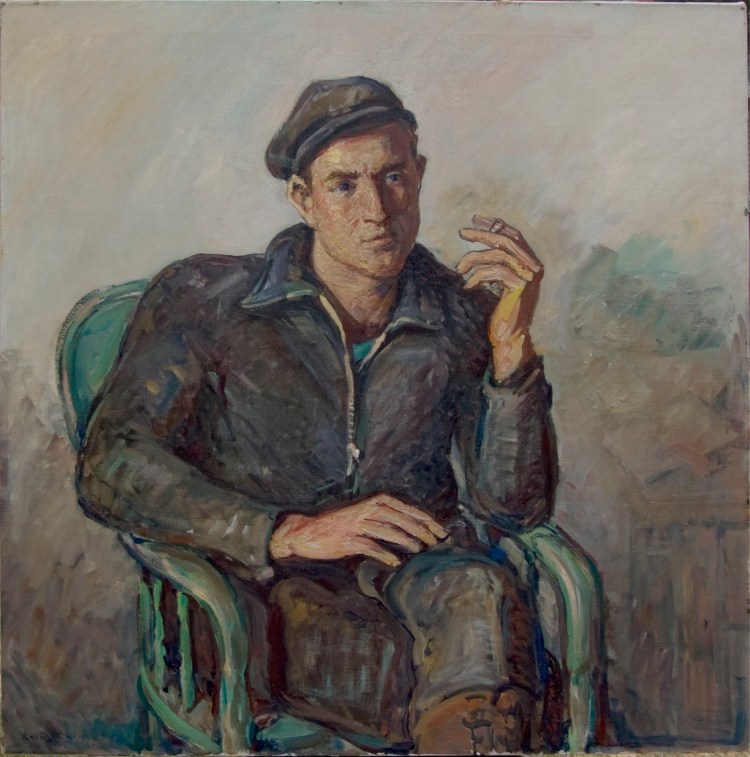

Russell Cheney, “Howard Lathrop (aka Kenneth Hill),” 1937, 36 x 36 inches Courtesy of Carol L. Cheney
Of considerable note is “Kenneth Hill,” of 1937, a portrait of a seated man smoking a cigarette that is actually someone else (Howard Lathrop). Cheney’s homoerotic gaze is unmistakable. There is a smoldering quality to his depiction of this handsome young man that would make many of Marsden Hartley’s beefcake beachgoers pale by comparison. This in itself makes the portrait pretty daring. Critics of the era skirted around the issue, only vaguely hinting at Cheney’s eroticism by alluding to his talent as “virile.”
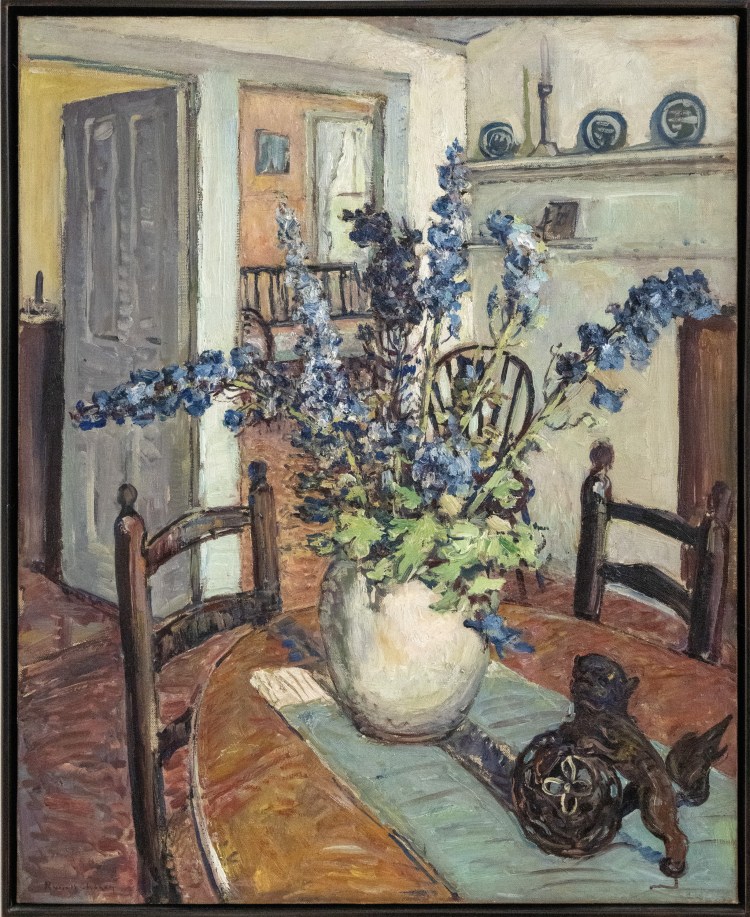

Russell Cheney, “Larkspur,” 1934, 36 x 29 inches Courtesy of Carol L. Cheney
But there are other lovely surprises, in particular “Larkspur,” an oil on canvas that takes an unconventional view (for the time) of a flower arrangement. It’s style, like that of other paintings, seems to be an amalgam of Impressionist and Post-Impressionist ideas. The blossoms themselves almost feel like van Gogh. While his faces hint at a knowledge of Pointillism with their encrusted stippled application of paint.
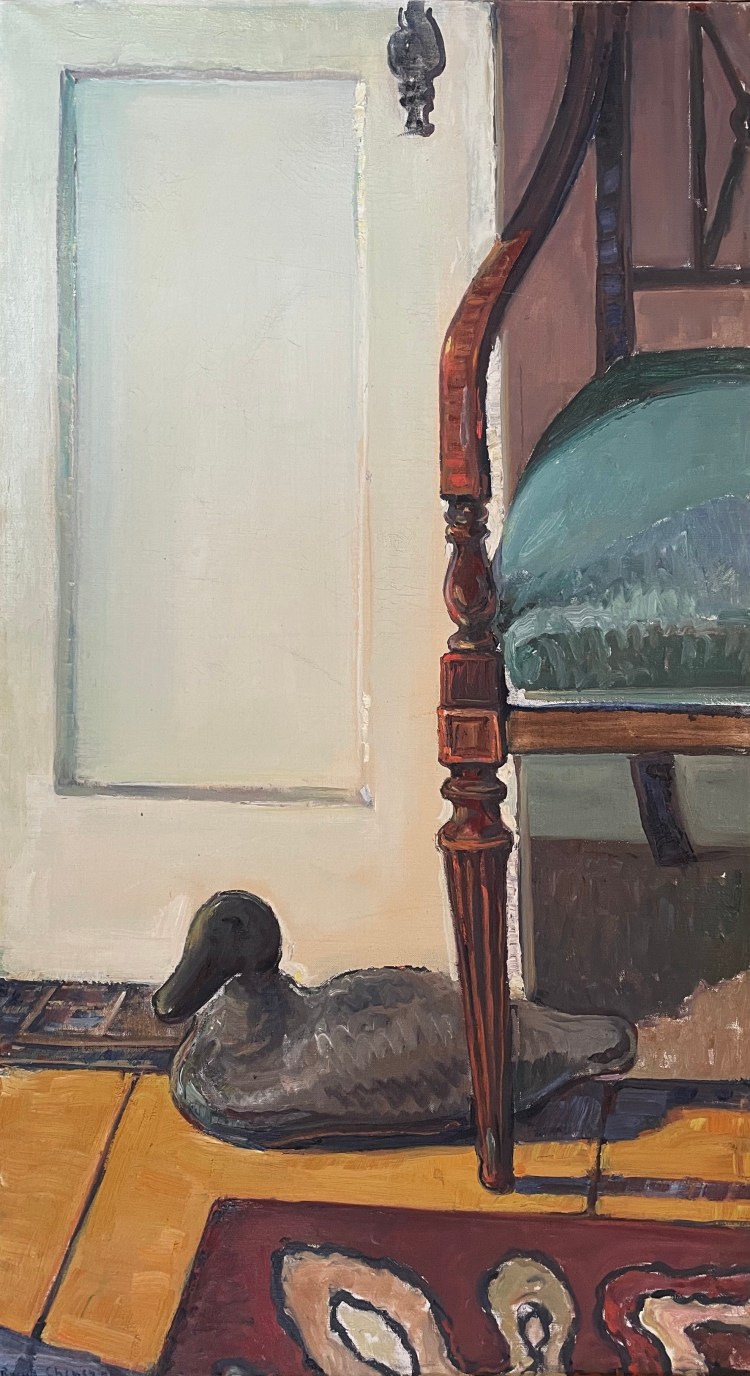

Russell Cheney, “Doorstop,” 1941, 36 x 20 inches Courtesy of Robert S. Chase and Richard M. Candee Revocable Trust
Yet he is syphoning all these styles through a midcentury lens. He is also interpreting stylistic languages of contemporaries, as with “Doorstop,” from 1941, which takes a page from Charles Sheeler, with its minimalist focus on individual objects and furnishings. It’s a spare composition that contains only five elements: a door, a chair, a duck decoy (the doorstop), a piece of rug and a wide-plank floor. It is unusual for a work this large to lavish such attention on such a simple frame. But we are very glad for it nonetheless.

